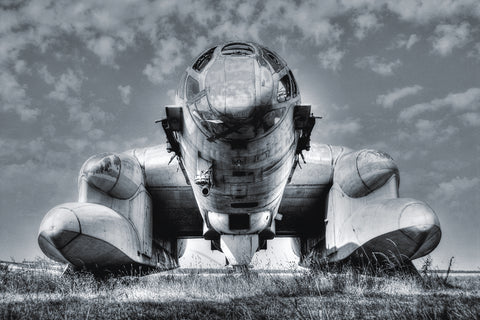
Is This the Weirdest Airplane You’ve Ever Seen?
In the 1950s and 1960s, the Soviet Union was greatly concerned about the United States’ submarine-launched Polaris missiles. The ballistic weapons carried small, relatively lightweight hydrogen bombs that could hit targets more than 2,000 miles away from their launch sites. Even more concerning, submarines could launch the missiles while remaining submerged. The Soviets were highly motivated to develop the means to identify, attack and destroy those submarines.
Its designer, Robert Ludvigovich Bartini
(photographed in 1973), moved to the Soviet Union in 1923, where he
contributed to several ground-breaking aero designs. (Science Photo Library)
Enter Robert Bartini. Born in Austria-Hungary (in what is now Croatia) in 1897, the illegitimate son of a baron, Bartini served in the Austro-Hungarian army during World War I and spent time as a Russian prisoner-of-war. After the war, Bartini made his way to Italy and became an aviation engineer and designer. He joined the Italian Communist Party before the rise of Italian fascism compelled him to leave for the Soviet Union in 1923. His career in his adopted country was both impressive and tragic; Bartini played a major role in the design and manufacture of 60 aircraft and aircraft projects, but he also spent years in prison, from 1938 until 1946, for his association with Marshal Mikhail Tukhachevsky, who was executed for treason in 1937, and because Joseph Stalin’s regime accused him, probably falsely, of spying for Italian dictator Benito Mussolini—even though it was the rise of Mussolini that had prompted Bartini to leave Italy. Even while in prison, Bartini worked as an aircraft engineer and designer, including contributing to the development of the Tupolev Tu-2 bomber.
The Bartini-Beriev VVA-14 was intended to
operate in ground effect. (FoxbatGraphics Image Library/Beriev)
Recommended for you
The Bartini-Beriev VVA-14 was both gargantuan and bizarre looking. The aircraft was nicknamed “Zmei Gorynich” because of its resemblance to a mythological multi-headed dragon of that name. With a wingspan of almost 100 feet and a length of 85 feet, the craft featured a high, straight-wing configuration and a long, protruding cockpit. Atop the wing were two large Soloviev D-30M turbofan cruising engines, each of which could produce 15,000 pounds of thrust. Starting engines were to be housed on each side of the nose. Enormous pontoons under the wing and on each side of the fuselage would facilitate seaborne operations. The undercarriage housed a nose gear and a main landing gear for conventional takeoff and landing (using hardware from Tu-22 bombers). VVA-14 could carry 34,000 pounds of fuel in two giant tanks. The planned VTOL engines, 12 Rybinsk RD-36-35 lift turbofans generating 9,700 pounds of thrust each, would occupy a large center space and use a series of air nozzles distributed across the airframe to propel the craft into the air. VVA-14 was designed to carry and deploy torpedoes, bombs and mines. Astonishingly, the imposing craft required only a crew of three—a pilot, navigator and weapons officer. VVA-14 had a service ceiling of approximately 30,000 feet.
VVA-14 was designed to be a wing-in-ground effect (WIG) vehicle. Such aircraft take advantage of the increase in lift that aircraft experience when flying close to the surface, especially when that surface is extremely flat (such as a runway or the sea). Aircraft designers had noted that straight-wing aircraft often functioned well as WIG aircraft, hence VVA-14’s straight wings.
Bartini believed the “Zmei Gorynich” would be
the perfect machine to seek and destroy Polaris missile-carrying submarines.
(Courtesy Andri salinkov)
Bartini’s airplane first flew in 1972. The aircraft was considered a success even though it had serious problems, including severe vibration from the two large Soloviev cruising engines, which caused significant buffeting and even broke the landing gear doors. At first the VVA-14 had inflatable pontoons (an unorthodox idea championed by Bartini himself). While those pontoons did work, they were ultimately replaced with rigid metal ones.
Bartini died two years later at the age of 77 (the cause of his death was not made public). Without his backing, the program found itself short of funding but still managed to limp along for two more years. The VTOL engines never materialized but the VVA-14 made 100 conventional flights. The Soviets had planned to build three aircraft but only one was completed. Eventually, the government stopped funding the program and the aircraft fell into disrepair. Currently, the VVA-14 airframe is on display at the Central Air Force Museum near Moscow, where it sits partially dismantled and minus its wing but with pontoons still affixed. Plans to restore the airframe never bore fruit.
In retrospect, VVA-14 seems to have been a victim of its own extravagance. The plane was too large, too heavy and was required to fill too many roles. With so many different, and novel, technologies crammed into a single design—any one of which may have needed its own airframe to fully vet—it’s easy to understand why the project was cancelled. VVA-14 is perhaps best remembered as a testbed for a plethora of divergent technologies, all welded into a single chimera-like aircraft.
this article first appeared in AVIATION HISTORY magazine
Facebook @AviationHistory | Twitter @AviationHistMag
